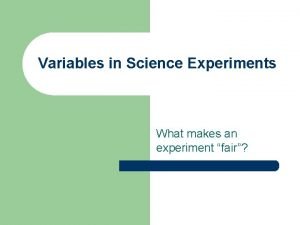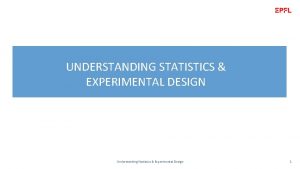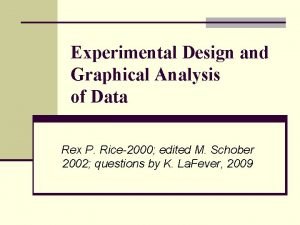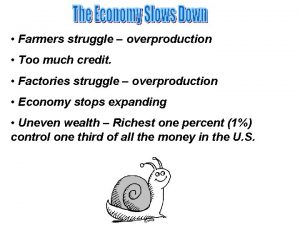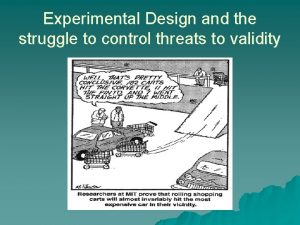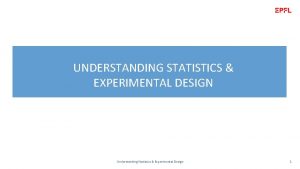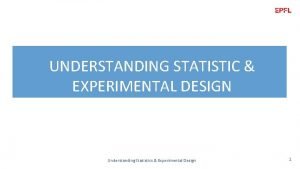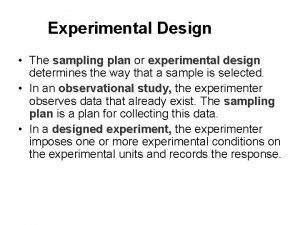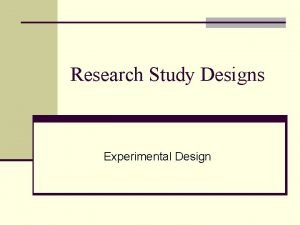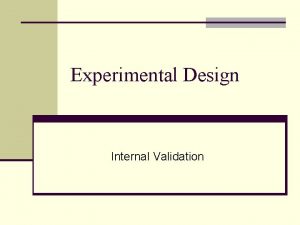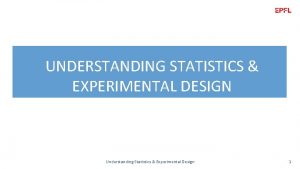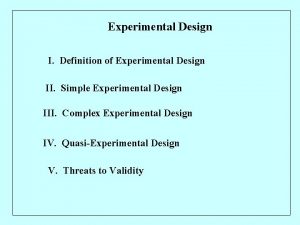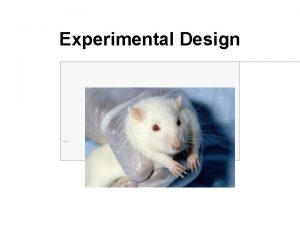EXPERIMENTAL DESIGN Experimental Design and the struggle to







































- Slides: 39

EXPERIMENTAL DESIGN

Experimental Design and the struggle to control threats to validity

NATURALISTIC INCREASINGLY CONSTRAINED LOW CASE-STUDY CORRELATIONAL DIFFERENTIAL EXPERIMENTAL HIGH

Experimental design is a planned interference in the natural order of events by the researcher.

What is Experimental Design? Experimental research allows us to test hypotheses and infer causality under controlled conditions designed to maximize internal validity. The high control and internal validity often mean a reduction of external validity. That is, the more precise, constrained, and artificial we become in the experiment, the less natural are the procedures and findings. The result is that we sometimes have difficulty generalizing experimentation to the natural environment, or a larger population.

Experimental Design Comparisons are made under different and controlled conditions. Subjects are assigned to each type of condition in an unbiased manner, usually matched or random. Although causality can often be inferred, results may not be applicable outside of the experimental setting Causality: If X, then Y AND If not X, then not Y

TIME 0: PRE-TEST. Collect baseline data. CONTROL TREATMENT #2 Experimental TREATMENT #1 TREATMENT #3

TIME 1: TREATMENT GIVEN CONTROL COKE Experimental JOLT COFFEE

TIME 3: POST-TEST. Collect data on the effects of the treatment and compare to pretest, and to each treatment. CONTROL COKE Experimental JOLT COFFEE

Hypotheses NULL (Statistical) mean JOLT= mean COKE = mean COFFEE = mean CONTROL RESEARCH (Causal) Caffeine causes people to grow tall and nervous. CONFOUNDING (Rival) The differences are due to the amount of citric acid in the drinks.

A simple 2 -group, posttest-only design Outfitters given lowimpact training Measure impacts caused by their clients Compare Scores Outfitters given NO low-impact training Measure impacts caused by their clients

Hypotheses NULL (Statistical) mean Trained= mean Un-trained RESEARCH (Causal) The clients of outfitters trained in low impact methods will cause fewer impacts than clients of outfitters who did not receive such training. CONFOUNDING (Rival) Prior knowledge may have caused the observed differences in response.

Threats to Validity

Reliability Repeated use of the measure with identical subjects yields identical and consistent results. It is improved by: Clear conceptualization Precise measurement Multiple indicators Pilot-testing

Validity Internal Validity– design and measurement concerns that reduces chances for internal errors. External Validity– describes our ability and intent to generalize to subjects beyond our study sample. Largely an issue of design and sampling.

Validity and Reliability Reliable, NOT valid NOT Valid but Reliable Valid, NOT Reliable Valid but UNReliable NOT Valid, NOT Reliable Valid AND Reliable NOT Valid and UNReliable Valid and Reliable

Internal Validity Specifically, measurement validity Measures are valid for a single purpose Three types of validity: Face—as judged by others or by logic Content—captures the entire meaning of the experience Criterion—agrees with a validates, reliable external source: Concurrent, agrees with a preexisting measure Predictive, agrees with a future behavior or outcome

Validity Because of the confounding Hypothesis we are not 100% sure that our conclusions are valid. Did we indeed measure the effects of new knowledge? Independent -- Dependent? Other Variable/s -- Dependent?

Road map for research success Anticipate all threats to validity. Take plans to eliminate them. Statistical validity Construct validity External validity Internal validity.

Statistical validity The variations in the dependent variable are not due to variation in the subjects, but due to variations in the measuring instrument. The instrument is unreliable. Some statistical assumptions have been violated (e. g. , non-normal data treated with parametric statistics; means of ordinal data, etc. ).

Construct validity How well the observed data support theory, and not a rival theory.

External validity The degree to which the findings of the study are valid for subjects outside the present study. The degree to which they are generalizable. Unbiased, complex sampling procedures; many studies, mid-constraint approaches help strengthen external validity. < external = > internal

Internal Validity Threats to causality (our ability to infer). Did the independent variable cause the dependent to change (were they related), or did some confounding variable intervene? Maturation, history, testing, instrumentation, regression to the mean, selection, attrition, diffusion and sequencing effects.

Maturation If the time between pre- and posttest is great enough to allow the subjects to mature, they will! Subjects may change over the course of the study or between repeated measures of the dependent variable due to the passage of time per se. Some of these changes are permanent (e. g. , biological growth), while others are temporary (e. g. , fatigue).

History Outside events may influence subjects in the course of the experiment or between repeated measures of the dependent variable. Eg. , a dependent variable is measured twice for a group of subjects, once at Time A and again at Time B, and that the independent variable (treatment) is introduced between the two measurements. Suppose also that Event X occurs between Time A and Time B. If scores on the dependent measure differ at these two times, the discrepancy may be due to the independent variable or to Event X.

Testing Subjects gain proficiency through repeated exposure to one kind of testing. Scores will naturally increase with repeated testing. If you take the same test (identical or not) 2 times in a row, over a short period of time, you increase your chances of improving your score.

Instrumentation Changes in the dependent variable are not due to changes in the independent variable, but to changes in the instrument (human or otherwise). Measurement instruments and protocols must remain constant and be calibrated. Human observers become better, mechanical instruments become worse!

Regression to the mean If you select people based on extreme scores (High or low), in subsequent testing they will have scores closer to the mean (they would have regressed to the center).

Selection When random assignment or selection is not possible the two groups are not equivalent in terms of the independent variable/s. For example, males=treatment; females=control. Highest threats in naturalistic, case study and differential approaches.

Attrition When subjects are lost from the study. If random it may be OK. Confounding attrition is when the loss is in one group or because of the effects of the independent variable. (Jolt killed off 2 people!)

Diffusion of treatment When subjects communicate with each other (within and between groups) about the treatment) they diffuse the effects of the independent variable.

Sequencing effects The effects caused by the order in which you apply the treatment. ABC ACB B A C, etc.

Subject effects Subjects “know” what is expected of them, and behave accordingly (second guessing). Social desirability effect. Placebo effect. A placebo is a dummy independent effect. Some people react to it.

Experimenter effects Forcing the study to produce the desired outcome. Expectations of an outcome by persons running an experiment may significantly influence that outcome.

Single- and double-blind procedures Single blind –subjects don’t know which is treatment, which is not. Double blind—experimenter is also blind.

Designs One shot: T------O 2 One Group Pre-Post: G 1 T=Treatment G 1 O 1 ------T------O 2 Static Group: G 1 G 2 (C) T------O 2 O=Observation (measurement) C=Control

More designs Random Group: RG 1 RG 2 (C) R=Random T-------O O Pretest-Posttest, Randomized Group: RG 1 RG 2 (C) O 1 ------T------O 2 O 1 -------O 2

Yet another design: Solomon four-group: RG 1 RG 2 RG 3 RG 4 O 1 ------T------O 2 O 1 -------O 2 T------O 2

One last one ! Latin Square: RG 1 RG 2 RG 3 O O O T 1 T 2 T 3 O O O T 2 T 3 T 1 O O O T 3 T 1 T 2 O O O
 Non experimental design vs experimental
Non experimental design vs experimental Experimental vs non experimental
Experimental vs non experimental Research approaches and designs
Research approaches and designs Disadvantages of experimental research
Disadvantages of experimental research Nonexperimental study
Nonexperimental study What is the independent variable in an experiment
What is the independent variable in an experiment Experimental design independent and dependent variables
Experimental design independent and dependent variables Statistics
Statistics Ethical consideration in experimental research sample
Ethical consideration in experimental research sample Experimental design questions and answers
Experimental design questions and answers How to linearize a top opening parabola
How to linearize a top opening parabola Hát kết hợp bộ gõ cơ thể
Hát kết hợp bộ gõ cơ thể Slidetodoc
Slidetodoc Bổ thể
Bổ thể Tỉ lệ cơ thể trẻ em
Tỉ lệ cơ thể trẻ em Gấu đi như thế nào
Gấu đi như thế nào Tư thế worm breton
Tư thế worm breton Hát lên người ơi alleluia
Hát lên người ơi alleluia Môn thể thao bắt đầu bằng chữ đua
Môn thể thao bắt đầu bằng chữ đua Thế nào là hệ số cao nhất
Thế nào là hệ số cao nhất Các châu lục và đại dương trên thế giới
Các châu lục và đại dương trên thế giới Công thức tính thế năng
Công thức tính thế năng Trời xanh đây là của chúng ta thể thơ
Trời xanh đây là của chúng ta thể thơ Cách giải mật thư tọa độ
Cách giải mật thư tọa độ Phép trừ bù
Phép trừ bù độ dài liên kết
độ dài liên kết Các châu lục và đại dương trên thế giới
Các châu lục và đại dương trên thế giới Thể thơ truyền thống
Thể thơ truyền thống Quá trình desamine hóa có thể tạo ra
Quá trình desamine hóa có thể tạo ra Một số thể thơ truyền thống
Một số thể thơ truyền thống Cái miệng bé xinh thế chỉ nói điều hay thôi
Cái miệng bé xinh thế chỉ nói điều hay thôi Vẽ hình chiếu vuông góc của vật thể sau
Vẽ hình chiếu vuông góc của vật thể sau Nguyên nhân của sự mỏi cơ sinh 8
Nguyên nhân của sự mỏi cơ sinh 8 đặc điểm cơ thể của người tối cổ
đặc điểm cơ thể của người tối cổ Thế nào là giọng cùng tên
Thế nào là giọng cùng tên Vẽ hình chiếu đứng bằng cạnh của vật thể
Vẽ hình chiếu đứng bằng cạnh của vật thể Phối cảnh
Phối cảnh Thẻ vin
Thẻ vin đại từ thay thế
đại từ thay thế điện thế nghỉ
điện thế nghỉ





